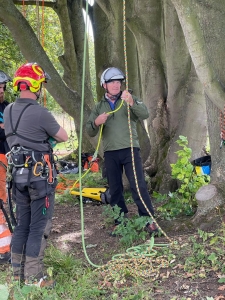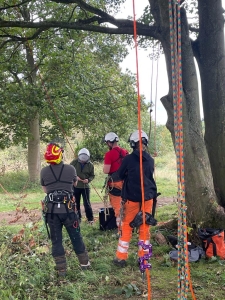
Our lead instructor, Phill Escritt, recently attended our Lantra accredited Stationary Rope Work Positioning course with John Trenchard, Here is his account of his experience and how he will be using SWRP going forward.
It doesn’t seem that long ago that I was convinced that SRT or SRWP was a passing fad which would have gradually disappeared into obscurity.
As someone who started their arb career climbing on a rope with a three knot system, and remembers the introduction of the prussik loop thirty years ago, I didn’t hold much hope for a new game changing climbing set up that was said to make my life easier.
Part of this was my stubbornness, I had climbed the old way for so long, I didn’t feel there could really be any great advancements. Another part, I think, was the fear of trying something so new after all this time that I would feel I was learning to walk again.
How wrong I was!
After recently undertaking the latest Lantra Stationary Rope Work Positioning and Rescue course, with John Trenchard, which is run as an integrated training assessment, my mind was blown.
I quickly realized that all my assumptions of how this style of tree climbing would be used, were completely wrong and this system of tree climbing had vastly more potential than I could have foreseen.
The ease with which I could gain height with minimum effort, was the one area which I had already grasped. But being able to switch between SRWP and my old MRS (moving rope system) inspired me. As someone immersing themselves into an entirely new way of accessing a tree, being able to briefly resort back to a tried and tested system when I felt it was suitable, gave me confidence.
Once the anchor points had been selected, with a canopy tie in place – both of which could be removed from the ground – the extra equipment which had allowed me to gain height so efficiently could be removed, this was another misconception that I would be carrying masses of extra equipment which I didn’t like the idea of.
The efficiency with which I could move around the crown was insane. The ropes being fixed meant no friction, I could choose any route through branch forks without the worry of increased friction or trapped ropes. I felt that in turn this allowed me to get further out with less effort. That with the added option of easily placed redirect to drop onto branches below me, branch walking was minimized. Also extremely apparent was the stability I felt when going on to branch extremities due to the pretensioned rope, and the minimum amount of bounce when returning from the end of limbs. And when there was a longer ascent to make, it was no effort to re-attach the kit I needed to ascend.
When aerial rescue was covered, it was easy to see just how efficient this could be, providing the rescuer was proficient in this technique.
All in all this was as extremely well received course by all those who attended. Discussions were had by those who had been taught that week, and the general consensus was, that SRT would definitely be replacing one of their two climbing systems, with it being likely that once confidence was increased, it may even replace the second system.
For more information about this course please visit the website vmtltd.net

